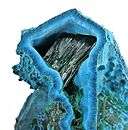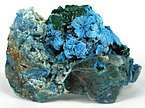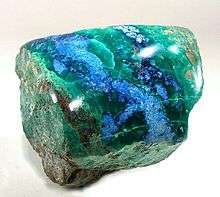Shattuckite
Shattuckite is a copper silicate hydroxide mineral with formula Cu5(SiO3)4(OH)2. It crystallizes in the orthorhombic – dipyramidal crystal system and usually occurs in a granular massive form and also as fibrous acicular crystals. It is closely allied to plancheite in structure and appearance.
| Shattuckite | |
|---|---|
 | |
| General | |
| Category | Inosilicate |
| Formula (repeating unit) | Cu5(SiO3)4(OH)2 |
| Strunz classification | 9.DB.40 |
| Crystal system | Orthorhombic |
| Crystal class | Dipyramidal (mmm) H-M symbol: (2/m 2/m 2/m) |
| Space group | Pcab |
| Identification | |
| Color | Dark and light blue, turquoise |
| Crystal habit | Commonly spherulitic aggregates of acicular crystals |
| Cleavage | perfect along [010] and [100] |
| Fracture | uneven |
| Mohs scale hardness | 3.5 |
| Luster | Dull to silky |
| Streak | Blue |
| Diaphaneity | Translucent to opaque |
| Specific gravity | 4.1 (rather heavy for a non-metallic mineral) |
| Optical properties | Biaxial (+) |
| Refractive index | nα = 1.753, nβ = 1.782, nγ = 1.815 |
| Pleochroism | X = very pale blue; Y = pale blue; Z = deep blue |
| References | [1][2][3] |
Shattuckite is a relatively rare copper silicate mineral. It was first discovered in 1915 in the copper mines of Bisbee, Arizona, specifically the Shattuck Mine (hence the name). It is a secondary mineral that forms from the alteration of other secondary minerals. At the Shattuck Mine, it forms pseudomorphs after malachite. A pseudomorph is an atom by atom replacement of a crystal structure by another crystal structure, but with little alteration of the outward shape of the original crystal. It is sometimes used as a gemstone.[4]
Gallery
 Shattuckite with malachite, about 4 cm wide. Kaokoveld Mine, Namibia
Shattuckite with malachite, about 4 cm wide. Kaokoveld Mine, Namibia Shattuckite crystals form concentric circular clusters of spraying, elongated, acicular crystals. Associated with them are small bits of contrasting primary malachite crystals in a deep green color
Shattuckite crystals form concentric circular clusters of spraying, elongated, acicular crystals. Associated with them are small bits of contrasting primary malachite crystals in a deep green color Botryoidal balls of shattuckite, from the Kaokoveld Mine, Kaokoveld Plateau, Kunene Region, Namibia
Botryoidal balls of shattuckite, from the Kaokoveld Mine, Kaokoveld Plateau, Kunene Region, Namibia Polished shattuckite with malachite, New Cornelia mine, Ajo, Arizona. Size 5.3×5.1×5.0 cm
Polished shattuckite with malachite, New Cornelia mine, Ajo, Arizona. Size 5.3×5.1×5.0 cm
References
| Wikimedia Commons has media related to Shattuckite. |
- Shattuckite. Webmineral.com. Retrieved on 2011-10-10.
- Shattuckite. Mindat.org (2011-09-08). Retrieved on 2011-10-10.
- Shattuckite. Handbook of Mineralogy. (PDF) . Retrieved on 2011-10-10.
- http://www.minerals.net/mineral/shattuckite.aspx